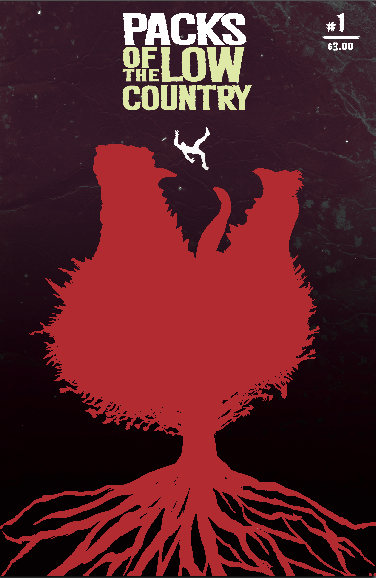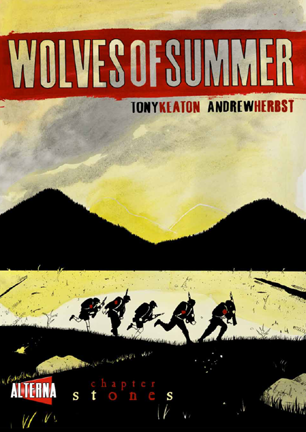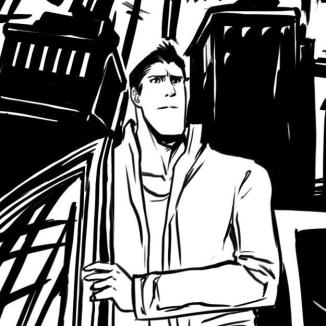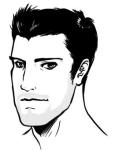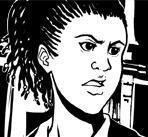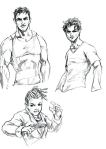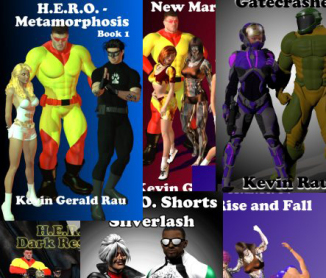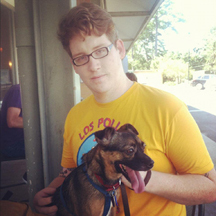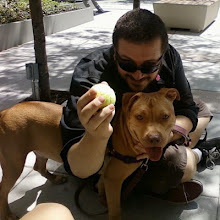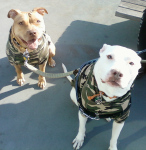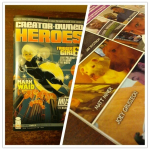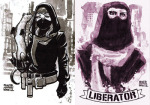 For our first edition of our Spotlight on awesome comic book shops, we talk with Kris Bartolome, main operator at Santa Rosa, California’s Comics FTW. This is an awesome and incredibly friendly guy with an amazing store, and we are very happy to have had this chance to question him a bit. So, here we go…!
For our first edition of our Spotlight on awesome comic book shops, we talk with Kris Bartolome, main operator at Santa Rosa, California’s Comics FTW. This is an awesome and incredibly friendly guy with an amazing store, and we are very happy to have had this chance to question him a bit. So, here we go…!
———-
- As an introduction - Name, Rank, and Serial Number?
Kris Bartolome. Owner, manager, and janitor of Comics FTW. I’m pretty much the only one here.
- Quick question - who came up with the shop name? I love it.
Oh man, I seriously spent about a month going back and forth on a long list of names. A lot of really terrible names: The Comic Spot, The Comic Shop of DOOM (yeah, all caps on “DOOM”), 2 Guys 1 Shop (I had a business partner in the early stages), On Comic Ground (Already taken, and in hindsight I really don’t dig the name), and a bunch of other really shitty ones. One day, I was talking to my cousin and asked him if anything really caught his attention and he randomly joked “You should just call it Comics FTW.”
- Comics FTW is a relatively recent addition to Northern California’s shifting collection of comic shops. I’m curious as to how the current world-wide financial situation, as well as any personal hurdles, might have made opening Comics FTW difficult? More to the point, how did you come to doing what every comic fan dreams of - opening your own shop?
I’ve been a comic fan since 3rd grade and like so many others, I’ve always dreamed of doing this. I worked for a little while at another shop owned by a good friend of mine, and became very familiar with the processes that go on in running a comic book store. I also did the retail grind after that for seven years, and studied Business and Economics in college. At some point, I decided that I didn’t like being so directionless and wanted to pursue this comic shop thing while I was young and still able to get back on my feet in case things flopped.
The biggest hurdle in opening a new comic shop is having the start-up capital. People like to have this idea that they can walk into a bank and just get a loan like it’s nothing, but the truth is that no bank or credit union wants to fund a risky venture like comic book retail. Opening the shop meant saving a LOT of my own income and draining a lot of my own credit cards.
- Though I first visited Comics FTW after you had been open for a bit already, I’ve been able to watch the shop grow and change for the better, and in many ways. Having being lead to your shop by your awesome subscription/pull list service, it makes me wonder what changes might be your favorite since you’ve opened? Also, what kind of ideas do you see for the near (or far) future?
Initially, my plan was to have a tiered discount system, with bigger discounts for longer pull lists. I immediately decided to make the 20% discount across the board when I saw that it was a big draw. Also, the decision to bag and board all comics on the wall was made the day before opening. I had always planned to offer free bags and boards for purchased comics, but I initially thought I’d be bagging and boarding at the counter as I sold the issues. After seeing the difference in visual presentation, it seemed like a no-brainer. It’s a lot of little stuff like that. How things are presented and displayed is important to me, and I think it’s made a difference in first impressions with the shop. Most of my changes revolve around making the shop look better, or making processes more efficient. That’s why people often comment that it feels like the shop is always changing. I just always find things to improve. I’ll never have a “perfect” shop.
- One of my favorite aspects of your shop has been the way you handle the “Variant” versions of certain issues that you get from publishers. Most stores mark them up and sell them for double digit prices, yet the way FTW goes about it is very different. Could you explain first how shops get these, and maybe some of the thinking behind the way FTW handles them?
Variant covers are usually incentives for retailers for ordering more copies of an issue. A shop can order one copy for every target amount of issues they order. It usually varies in how much a shop has to order, and can be anywhere from 10 to 1000. These variant covers almost always sell well above retail price, but the cost is the same as one regular issue (provided you order the target amount of regular issues). It wouldn’t be unusual for a store to set these issues aside and mark them up and sell them at these higher prices. Stores have been doing this forever. I actually raffle off any variants for free. In order to be qualified, you just have to be subscribed to a series that gets a raffle. After a couple weeks, I randomly grab a name and drop the variant into that subscriber’s box.
Generally speaking, I prefer to think long-term with most aspects of my business. Raffling rare covers in this way foregoes any profit I would’ve made on those items, but is a very attractive feature to subscribers. Folks have more incentive with asking me to pull their books for the next few months or years. I’m sure other owners and even customers think my decision to do this is crazy, but I know my current subscribers are happy about it and I know that new, prospective subscribers find it interesting.
- You also run a good number of ‘special nights’ like your HeroClix Tournaments, group artwork sessions, midnight comic releases and more! What’s your favorite among these, and what plans do you have for future ‘special’ things like these?
The game nights are fun, but the midnight releases and Free Comic Day are great business days, but my favorite is our Chill N’ Sketch nights where artists of all ages and skill levels hang out at the shop and just draw. It’s awesome because it fosters this really fun community of cool people with shared interests, and more and more people become interested in being involved in it. I’m always looking for things to set this shop apart from the others, especially in ways that make the business feel closer to the community. Things like Chill N’ Sketch make the shop less “the place where we buy comics” and more “that place we love going to and want to support.”
- Speaking from your own sales at Comics FTW, rather than the overall sale numbers world or nation-wide, what has been the most successful ongoing title for you, so far? On that same note, which of the major crossover events have made the biggest splash? Are there any that you’re looking forward to, in either a personal or business sense? How about any that you’re not too excited about?
People don’t know this, but DC’s New 52 launch pretty much tripled my subscriptions. The first year was a real struggle, then this amazing (and controversial) thing happened and, for me, DC accomplished what they set out to do. It just made business a lot easier for me, and attracted so many new comic readers.
Event-wise, we did a midnight launch for Avengers vs. X-Men and it ended up being this huge party and drew a lot of attention to the crossover. I’ve had more subscribers for that main series than any other book. The events do well for me because of all the extra tie-ins that people want to buy, regardless of how good the story turns out to be. As a fan, I’m not too fond, but as a businessman, I keep my mouth shut. That’s not to say all of them are bad, but I’ve learned to be neutral about my tastes.
- You have an incredible amount of independent titles, from new issues to collections. Have any favorites? On the ‘business’ side’, which title/collection seems to be the most popular?
I’m not sure if Image Comics count as indy anymore, but a lot of their titles are doing extremely well lately. I do sell a decent amount of smaller press books, but the majority of them are through subscriptions as opposed to selling off of the comic wall.
- The DC and Marvel competitiveness seems to be reaching a new level, what with DC’s “New 52” and the recently launched “Marvel NOW!”. Knowing that “Marvel NOW!” is still in its initial launch phase, while DC’s “New 52” has already entered its 2nd year, what do you feel have been the strengths and weaknesses with the two?
The strength of New 52 is it’s across the board revamp. Anyone can jump into a book without any previous knowledge of the character’s history. I had new subscribers that were much more open-minded because they didn’t have to worry about going back too far. At the same time, a lot of the creative direction for most of the characters didn’t change too much. A few books did have some drastic changes, and some of the books were just very good in general, but it didn’t feel like the majority of it was “new”. Alternatively, it feels like Marvel NOW has taken a lot of key books in very different creative directions, bringing a fresh perspective on old characters. At the same time, a lot of these aren’t as well-received as the New 52 books were, and some are just downright horrible.
- Running a comic store usually means little to no time to actually read and experience some of your product, but I wonder - any individual title, trade collection, or graphic novel that has been important and/or cool enough that you’ve been unable to resist keeping up with or sitting down to read (in the case of trades and graphic novels)?
The truth is, my personal monthly read list is pretty small. But I always stop everything I’m doing when I pull one of the titles out of the box and read it then and there. I actually read a little of everything (good or bad) to keep up with what’s going on, but currently the only things I really wait for are: Saga, Walking Dead, Batman, and Avengers. The list rotates often though. Scalped was easily my favorite book, but it ended last year. I also really dug Wolverine and the X-Men but I just haven’t been feeling it lately. I always keep an eye out for new crime/noir and horror stuff that generally comes out more sporadically.
- You have a very wide variety of non-print comic memorabilia, as well as items from other mediums such as film and television. I must say, every time I visit I get lost in all of the figures, collector sets, etc. What are some of the Top Sellers in this area, as far as character, film, TV show, etc.? What would you say was the overall favorite? Any come to mind that have been difficult to move?
For toys, I move a LOT of older Marvel figures. It’s hard to compete against big box retailers with new action figure lines, so I tend to focus on secondary market items. Marvel figures, particularly Marvel Legends, are always popular. Superhero figures in general sell a lot better for me than Star Trek, GI Joe, or Star Wars stuff. I also stopped carrying a big selection of busts and statues as those don’t seem to move very well either, regardless of who the character is.
- Just about every fan has that one comic, that one character, or that one graphic novel that changed the way they saw the medium. For some it can be something that simply just opens their eye to the fact that comics are *awesome*, while others it’s something that took their already comic-loving mind and blew it open with new possibilities of what comics are capable of. What would yours be?
I first started reading comics in elementary school with those old Marvel Team-Ups, and continued from there into a LOT of 80’s and 90’s X-Men. I’d say my view of the medium in general changed after I read The Dark Knight Returns. I’d never really been exposed to the darker, grittier side until that book, and I read Watchmen not too long after.
Sometime in high school, I was doing a research paper on comics in the 60’s and found a bunch of books on more underground stuff by creators like Robert Crumb. That led me into reading things from Harvey Pekar, Daniel Clowes, Peter Bagge, Adrian Tomine, the Hernandez brothers and a bunch others. I’d say high school was when my comic tastes expanded the most, as I was looking for new reading in every genre and I came to be more open-minded about indy books.
- Care to talk a bit about some of your favorite people in comics? I mean in regards to writers, artists, etc.? Any new ones you’ve gotten into? Any old favorites who have kept their work strong all this time?
I’ve got a soft spot for Sergio Aragones. My dad took me to my first Comic Con when we lived in San Diego, and as an elementary school kid, I was lost. Then one day, this guy calls out to me to come over to his table and asked if I knew about Groo. He showed me a bunch of his work, drew a sketch of Groo for me, and gave me a signed copy of a first issue. I didn’t realize until way later who he was.
When I first started reading comics, I was all about Spider-Man, and Todd McFarlane was the guy. Him, Erik Larsen, and Jim Lee were my favorites. As I came to appreciate writers more in my older years, I tended to like Chris Claremont at first, then Kurt Busiek, Mark Waid, and a few others.
Nowadays, I’m a huge fan of Jason Aaron, Jonathan Hickman, and Brian K. Vaughan. My favorite artists are Olivier Coipel and John Romita Jr. I try not to exclusively follow certain creators though, and I’m always checking out new stuff.
- Final question, and a common and cheap one, at that! Who’s your favorite comic book character, superhero or otherwise?
I started with Spider-Man, and I’m pretty sure it’ll always be Spider-Man. He’s the underdog, but he’s got heart and the true essence of his character isn’t his powers, but his sense of responsibility. Plus he’s fun to read, and that’s the most important thing to me about comics.
___________________________
MORE INFORMATION
MAIN WEBSITE: http://comicsftw.com/
FACEBOOK PAGE: https://www.facebook.com/comicsftw
___________________________
PHOTOS:
-

-
COMICS FTW!
-
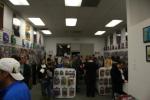
-
Inside the shop.
-

-
HeroClix night!
-
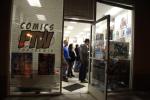
-
A great photo of right outside the shop.
___________________________

